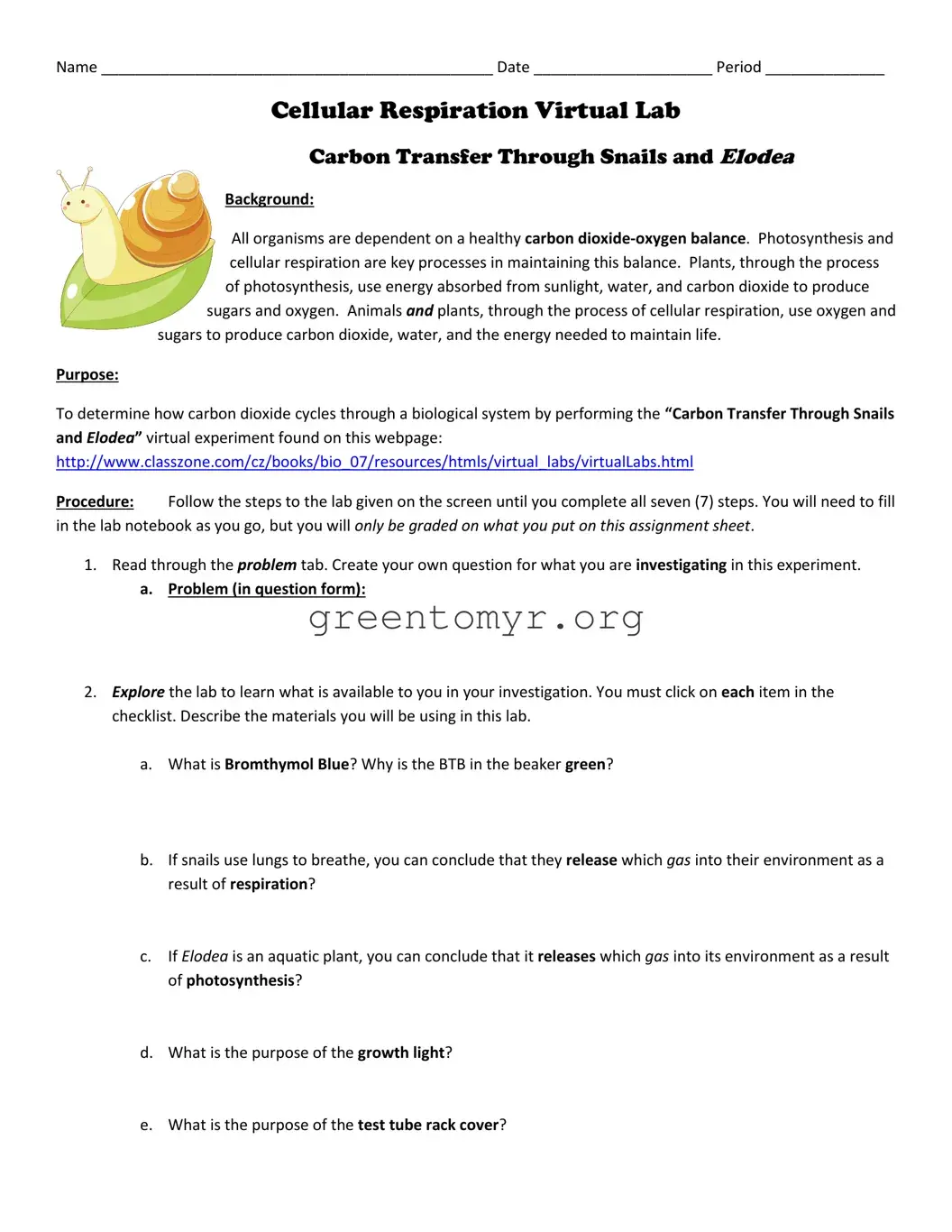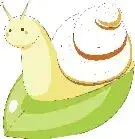Name ______________________________________________ Date _____________________ Period ______________
Cellular Respiration Virtual Lab
Carbon Transfer Through Snails and Elodea
Background:
All organisms are dependent on a healthy carbon dioxide-oxygen balance. Photosynthesis and
cellular respiration are key processes in maintaining this balance. Plants, through the process of photosynthesis, use energy absorbed from sunlight, water, and carbon dioxide to produce
sugars and oxygen. Animals and plants, through the process of cellular respiration, use oxygen and sugars to produce carbon dioxide, water, and the energy needed to maintain life.
Purpose:
To determine how carbon dioxide cycles through a biological system by performing the Carbon Transfer Through Snails and Elodea virtual experiment found on this webpage: http://www.classzone.com/cz/books/bio_07/resources/htmls/virtual_labs/virtualLabs.html
Procedure: Follow the steps to the lab given on the screen until you complete all seven (7) steps. You will need to fill in the lab notebook as you go, but you will only be graded on what you put on this assignment sheet.
1.Read through the problem tab. Create your own question for what you are investigating in this experiment.
a.Problem (in question form):
2.Explore the lab to learn what is available to you in your investigation. You must click on each item in the checklist. Describe the materials you will be using in this lab.
a.What is Bromthymol Blue? Why is the BTB in the beaker green?
b.If snails use lungs to breathe, you can conclude that they release which gas into their environment as a result of respiration?
c.If Elodea is an aquatic plant, you can conclude that it releases which gas into its environment as a result of photosynthesis?
d.What is the purpose of the growth light?
e.What is the purpose of the test tube rack cover?

f.Draw the picture seen on the CO2 – O2 Cycle poster.
g.If no carbon dioxide is present in your test tube it will be a ____________ color. If a medium amount of CO2 is present, your test tube will be a _______________ color. If a large amount of CO2 is present, your test tube will be __________________.
3.Hypothesis:
Explain how carbon dioxide (CO2) cycles in aquarium water through snails and Elodea.
If_____I add a snail and elodea to a test tube with bromthymol blue______
then_______________________________________________________________________
___________________________________________________________________________
because____________________________________________________________________
___________________________________________________________________________
4.The independent variable in an experiment is the variable which will be altered by you, the scientist. In the case of this experiment, the independent variable will be the number of snails and/or number of elodea plants in each test tube.
a. Identify the dependent variable(what you, the scientist, will measure) in this experiment:
5.Data/Results:
You will be using 8 test tubes for this experiment. Fill your test tubes and perform the experiment according to the data chart found below.
First Test Tube Rack – Placed under the growth light:
Test Tube |
Independent |
Beginning |
Color |
Color |
with BTB |
Variables |
Color |
Prediction |
Result |
|
|
|
|
|
TUBE # 1 (CONTROL) |
NO SNAILS, NO ELODEA |
GREEN |
|
|
|
|
|
|
|
TUBE #2 |
2 SNAILS |
GREEN |
|
|
|
|
|
|
|
TUBE #3 |
2 ELODEA |
GREEN |
|
|
Second Test Tube Rack – Placed under the test tube cover:
Test Tube |
Independent |
Beginning |
Color |
Color |
with BTB |
Variables |
Color |
Prediction |
Result |
|
|
|
|
|
TUBE # 1 (CONTROL) |
NO SNAILS, NO ELODEA |
GREEN |
|
|
|
|
|
|
|
TUBE #2 |
2 SNAILS |
GREEN |
|
|
|
|
|
|
|
TUBE #3 |
2 ELODEA |
GREEN |
|
|
|
|
|
|
|
TUBE #4 |
2 SNAILS, 2 ELODEA |
GREEN |
|
|
|
|
|
|
|
6.Conclusions:
Complete the following sentences.
a.In the test tubes which contained only snails….
b.In the test tubes which contained only Elodea under the light….
c.In the test tubes which contained only Elodea in the dark…..
d.In the test tubes which contained both snails and Elodea under the light….
Discussion:
1)Conclude. What is the relationship between snails and Elodea?
2)Analyze. Why did the color of the Bromthymol Blue (BTB) solution change in certain test tubes?
3)Analyze. What was the importance of a control in your experiment? What would you conclude if the color of the solution in the control changed?
4)Infer. When you began the experiment, was there CO2 in the water? In the test tubes that contained Elodea, where did the CO2 go?
5)Infer. Which gas did the snails release? What observation supports this inference?
6) Apply. Based on the results of your experiment, explain why you need to add the Elodea to your snail aquarium.



